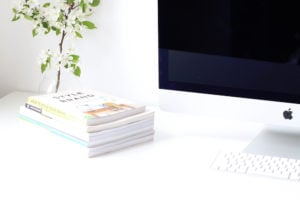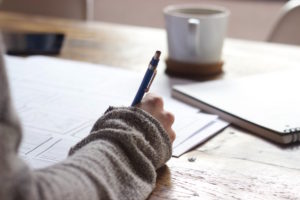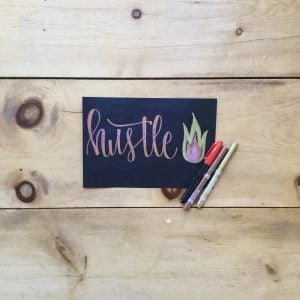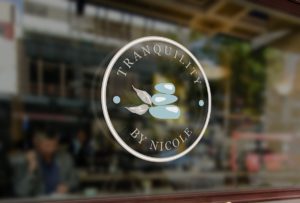Designing a logo is much more than slapping together the name of the business and an icon. It’s a representation of your brand and should elicit a feeling among your customers. It’s how people identify and remember your business. Your logo shouldn’t be something that you need to refresh every few years. A good designer will create a logo that’s timeless and won’t need to be redesigned to keep up with trends. Every graphic designer’s creative process is unique so today I’m sharing insight into how we do it:
1.Incoming inquiry
The obvious first step: a request! For me, these typically come via word-of-mouth referrals but Instagram is a major source for logo inquiries as well.
2. Respond
Next, I respond to the inquiry with a few important questions. If the inquiry comes from someone local, I often ask these questions over coffee. More often than not, we stick to email and the occasional phone call to communicate. The questions I ask at this time include:
- What does your business do?
- Do you have a strict deadline?
- Are you looking for an entire branding package (including mood board, fonts, colours, social media templates)?
- Do you have a website?
These are very high level questions that help me determine whether or not the project is a good fit for us both. I ask more detailed questions once we’ve decided to move forward with the project.
3. Proposal & Signature
Based on the answers I receive from the aforementioned questions, I put together a proposal that details out the project deliverables, timeline, cost, and payment structure. Once the client has reviewed and agreed to the terms, they’ll sign and send back by email.
4. Logo Design Questionnaire
Yay! I’ve just landed another logo design client. Now it’s time to really dig into the nitty gritty details of the business and customers. This is one of the most important steps as it helps eliminate the need for the revisions and really allow me to nail it on the first try. I have a questionnaire which I send out to new clients, however I tweak the questions for specific clients or circumstances. Some of the questions I ask include:
- What do you sell?
- Who are your competitors?
- What 3 words describe your business?
- What is your reason for redesigning your logo? (if applicable)
- What feelings do you want to instill in people when they first see your logo?
- Your ideal customer’s:
- Age
- Male/female
- Location
- Occupation
- Income
- Hobbies
- Status & children
- Personality type
- What colour palettes do you prefer?
- Link to 3 logos you really like
- Link to 3 logos you really dislike
- Where will you be using your logo? (website, business cards, trade show banners, social media, large posters, etc.)
These are just a few of the questions I ask in my logo design questionnaire. In order to present a logo that my client feels is perfect, these questions are extremely important. Sometimes, if I don’t feel that I have gathered enough information, I will hop on the phone with the client to talk through the questions as that’s often easier than writing in words.
5. Research
Now it’s time to get started! With the information I collected from the questionnaire, I start researching. I explore the industry, persona (ideal customer) characteristics, competitors, then move onto logo inspiration research. Contrary to what most people think, designers (myself included) typically draw upon inspiration from unexpected places. Like the design on my cashew milk carton, the tin sign on my garage wall, the shadow my aloe vera plant casts on the floor, or even non-visual things like song lyrics!

6. Sketches
Once I feel I have enough information to start drafting some ideas, I head to my trusty notepad with a pencil. My first sketches are messy and often don’t even include the name of the company. It’s an opportunity to start visualizing my concepts without getting distracted by colour or font. I usually do a few rounds of sketches. Once I’ve narrowed down my scribbles to 3-4 that align with the business and target customers, I’ll redo those sketches with a little more detail.

7. Scan and/or Illustrate
Some of the logos I design are a production of my own handlettering as opposed to purchasing a font typeface. Once I’ve perfected the lettered company name, I scan the design and pull it into Adobe Illustrator. I clean up the edges, and convert the lettering to a vector image so it can be resized and placed on an image without getting pixelated. If the logo is not handlettered, I start in Illustrator to draw any of the custom elements using the pen tool.

8. Refine
This is where I add colour, effects, try different fonts, and start to finalize the logo design. I typically switch to Adobe Photoshop for this.

9. Mockup
Arguably my favourite part of logo designing is mocking it up. This is when you place the logo onto real life items like business cards, storefronts, or to visualize how it will look. Ok so it’s probably not my favourite aspect because it involves very little design, but it’s incredibly rewarding to see the logo “come to life” and really boosts my confidence.

10. Present Concepts to Client
Depending on the scope of the project, I’ll often include two concepts for the client to choose from. At this point, I present the two logos and mockups in a package sent by email. If the client is local, I’ll present the concepts in-person. When sharing concepts with the client, I find it’s extremely important to include a short story about each of the logos. What makes it unique? How will customers feel upon seeing it? How are the two different?
11. Tweak (if necessary)
I can usually avoid having to make any tweaks but sometimes the client will request a small modification to a colour or font. My questionnaire and discovery period usually eliminate the need for any major revisions.
12. Send Final Files
Just about finished! At this point, I share the final logo files in a zipped package. I include a:
- JPEG
- PNG
- EPS (vector)
Sometimes, clients aren’t familiar with the various types of logo design files so I include a short description of each and when to use them.
So there you have it! Each designer will use a different creative process but most will include variations of discovery, research, conceptualize, and design.
Got questions about giving your logo a refresh? Shoot me an email!



